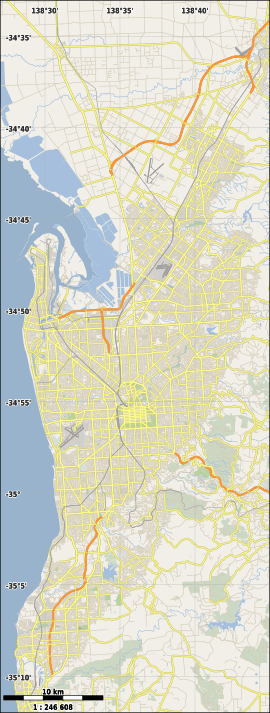Glenunga, South Australia facts for kids
Quick facts for kids GlenungaAdelaide, South Australia |
|||||||||||||||
|---|---|---|---|---|---|---|---|---|---|---|---|---|---|---|---|
| Established | 1860 | ||||||||||||||
| Postcode(s) | 5064 | ||||||||||||||
| Location | 5 km (3 mi) southeast of Adelaide | ||||||||||||||
| LGA(s) | City of Burnside | ||||||||||||||
| State electorate(s) | Unley | ||||||||||||||
| Federal Division(s) | Sturt | ||||||||||||||
|
|||||||||||||||
Glenunga is a friendly suburb located in the southeastern part of Adelaide, the capital city of South Australia. It's about five kilometers (around 3 miles) southeast of the city center. The name "Glenunga" is a mix of Aboriginal and Scottish words. "Unga" means "near" in an Aboriginal language, and "glen" comes from the nearby area called Glen Osmond. This leafy suburb has a rough triangular shape, bordered by Windsor Road, Portrush Road, Glen Osmond Road, and Conyngham Street.
Contents
History of Glenunga
Glenunga, along with its neighbor Glenside, was once known as 'Knoxville'. The first European settlers arrived in the 1840s and started farming. They grew wheat, and their wheat even won a top prize at the famous Royal Adelaide Show!
Early Businesses and Innovations
In 1882, places for processing meat (slaughterhouses) were built where Glenunga International High School and Webb Oval are now. These businesses grew so much that they exported meat overseas and supplied half of Adelaide's lamb!
In the 1870s and 1880s, several coach companies, like those owned by William Rounsevell, Cobb & Co, and John Hill, set up shop here. At one point, up to 1,000 horses grazed the land. Many streets were named by the people living there, often after their hometowns in England, Ireland, Scotland, Wales, or the United States. However, one street, "Allinga," got its name from an Aboriginal word meaning "sun."
In the early 1900s, Glenunga was home to interesting businesses. The famous Hills Hoist, a clothesline that became a symbol of Australia, was invented by the Hill family right here in Glenunga! Other businesses included Symons & Symons glass merchants and a company making "Bland Radios."
Growth and Community Changes
A church was built in Glenunga in 1926, and a larger one, dedicated to St Stephen, was constructed in 1956. After World War II, Glenunga changed from a farming area to a place where many people lived, with new residents moving in from the United Kingdom and other countries. St. Stephen's Church was taken down in 1999, and the church community moved to Glen Osmond. A special plaque was left behind to remember where the church once stood.
Geography and Green Spaces
Glenunga is a very green suburb with lots of trees. While it doesn't have many large parks within its borders, the nearby suburb of Glen Osmond has more parks, including the popular Ridge Park. The Glenunga Uniting Church is located at the corner of L'Estrange Street and Bevington Road.
Getting Around Glenunga
Public transport in Glenunga mainly uses buses. Buses run along Glen Osmond Road every 15 minutes until 6 pm, and there are other bus routes that go into the city. You can also catch the cross-city circle line along Portrush Road. These buses are part of the Adelaide Metro network.
Most people in Glenunga use cars to get around. The suburb is well-located, bordering Portrush Road and Glen Osmond Road. This makes it easy for residents to reach the Adelaide city centre and the Adelaide Hills via Glen Osmond Road and the South Eastern Freeway.
Glenunga's Population
| Historical population | ||
|---|---|---|
| Year | Pop. | ±% |
| 2001 | 1,794 | — |
| 2006 | 1,869 | +4.2% |
| 2011 | 1,867 | −0.1% |
| 2016 | 2,004 | +7.3% |
| 2021 | 2,184 | +9.0% |
| Data from the Australian Bureau of Statistics | ||
Glenunga is home to many families and older residents.
Things to See and Do
Because Glenunga is a smaller suburb, it has one main park called Glenunga Reserve, which also includes Webb Oval. The most well-known feature of Glenunga is the Glenunga International High School. This school is a big part of the suburb and is located roughly in the middle. Its growth has made L'Estrange Street, once a quiet road, quite busy with traffic and students during peak times.
You can find a number of businesses and shops along Glen Osmond Road and Conyngham Street. These include a McDonald's, Chinese and Mexican restaurants, and several smaller shops and motels.


